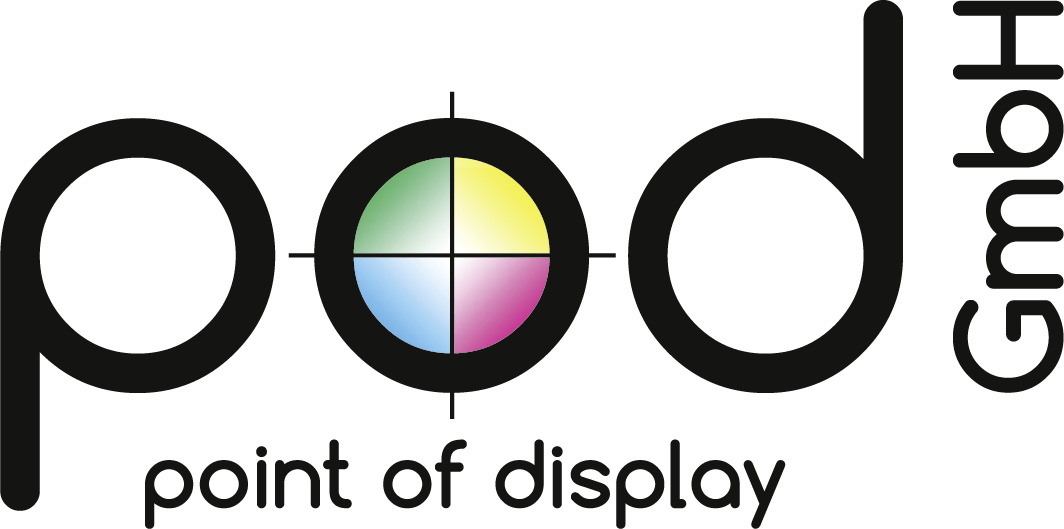Our pod company history
Milestones of pod GmbH from Braunschweig
We can look back with pride on more than 100 years of company history. Heinrich Michehl laid the foundation stone in 1907 with the establishment of the Michehls Atelier, which soon became the first screen printing company in Germany.
In the years that followed, the studio developed into a successful company thanks to new production processes and a focus on the development and manufacture of displays. Since 1 October 2014, this product specialization has been highlighted by the change of name to pod GmbH – point of display & offset.
How it all began
In 1907, Heinrich Michehl founded Brunswick’s oldest advertising materials company at Humboldtstraße 3 under the name “Michehls Kunstgewerbliches Atelier”.
Art and culture as clients
Initially, the studio concentrated on advertising painting, but commissions in the field of theater painting and stage design soon followed, as a letterhead from 1926 attests. The studio became particularly well known for its stage designs at the Braunschweig Operetta Theater and for the production of cinema posters.
Outdoor advertising with that special something
The studio provided the three Ufa theaters in Braunschweig at the time with new outdoor advertising every week, providing information about the latest films. In addition, the portfolio also included advertising media such as shop window advertising, in some cases in movable form, gable advertising, floats for parades, advertising stands for exhibitions, glass banners and much more.
The first displays are created
On February 1, 1936, Hermann Michehl, a nephew of the founder, and Heinrich Bethmann, the company’s first employee, acquired the advertising studio for 15,000 Reichsmark, payable in weekly installments of 31 Reichsmark each. The production facility moved to Nordstraße 7, where the cinema advertising was painted on wooden frames with linen coverings and then transported to the individual cinemas on wooden carts to be hung up on site and further decorated as required. From 1938, the first displays were produced on a small scale.
With the acquisition of the screen printing license, Michehls Atelier was the first screen printing company in Germany.
Post-war period
During the Second World War, entrepreneurs continued to produce advertising materials even under the most difficult conditions. Between 1946 and 1950, Heinrich Bethmann even continued to run the business alone, as Hermann Michehl was a prisoner of war until 1951. It was not until around 1950 that life had normalized enough to allow the company to develop further.
The time of removals
The most difficult problem in the 1950s was finding a new production facility. Within 14 years, the company produced at five different locations in Braunschweig, for example from 1950 to 1957 in Eschenburgstraße and Celler Straße.
Screen printing as a source of income
In the decade of the economic upswing, the lettering of exterior facades, company vehicles and vehicles of Braunschweiger Verkehrs AG was an important topic for Michehl’s studio – in addition to cinema advertising. At the end of the 1950s, the company produced large quantities of signs using screen printing. Under the most primitive conditions, the employees prepared the screens for printing in bathtubs at home.
In 1953, the Association of German Screen Printers was founded in Hanover with the help of the two Braunschweig experts Michehl and Bethmann.
Expansion to include offset printing
In 1957, at the time of the 50th anniversary celebrations, production took place at two locations, in Sackweg/Mittelweg and in Celler Straße. After a fire in 1958, the studio moved to the old streetcar depot on Eisenbütteler Straße. This is where the foundation stone for offset printing was laid at Michehls Atelier. With the acquisition of the offset press in 1959, Rotaprint R 30 1-color in DIN A3 format could be printed at a speed of 4,000 sheets per hour.
The studio expands
On January 1, 1960, the studio moved into the newly constructed company building at Weinbergweg 36, a new building with approx. 900 square meters of office and production space on a 2,312 square meter site.
Just seven years later, the company building on Weinbergweg was bursting at the seams, so the “Auf dem Anger” building in Bienrode was a welcome expansion. From then on, there was a division of tasks between the two plants.
The employees in Weinbergweg were responsible for lithography, screen and offset printing. The colleagues in Bienrode produced displays and had to take care of the processing and shipping tasks.
In 1974, Peter Michehl, who had been with the company since 1961, took over the management from his father. Lutz Bethman Sr. joined the company in 1948 and took over the management from his father in January 1968.
New possibilities
In 1979, the entire company moved to the new premises in Veltenhof, Heesfeld 2. The two existing premises had proved to be impractical. All employees and machines have now been accommodated in the 3,200 square meter company building on the 6,500 square meter site.
New technology
New technology also moved in with the move, including the three Roland Ultra 2-color printing presses in the so-called 5-format (89×126 cm) and the first facsimile gluing machines. The old Prakma laminating line had to make way for the second floor laminating line. The first WUPA punching machine was also installed.
Advertising displays for well-known companies
In the 1980s, further MIDIWAs were produced for VW, Renault and Ford, among others, which were ideal as presentation advertising media for new vehicles.
In order to present the new Escort model in various European countries, Ford commissioned Michehls Atelier with the largest order to date to design a corresponding display wall and ship it throughout Europe.
Change in the management
Lutz Bethmann Sr. left the company in 1991. Peter Michehl took over responsibility as sole managing partner. The photo is from 1995 and shows, from left, Lothar Wenzig (authorized signatory), Peter Michehl and Lutz Bethmann jun. who has been with the company since 1987.
Environmental statement 1997
1994 saw a further technical upheaval with the purchase of the Roland 800 four-color press. Significant investments were also made in screen printing. A new Printmaster fully automatic machine was joined by a biofilter system and a waste water treatment system. The last two investments were a prerequisite for obtaining the eco-audit, in connection with which the company’s own environmental statement was issued.
90th company anniversary
90 years after the company was founded, Michehls Atelier held a big anniversary celebration on June 20, 1997. The numerous guests, including the then Minister of the Interior of Lower Saxony, Gerhard Glogowski, and the Chief Representative of Nord/LB, Dietrich Fürst, celebrated the anniversary together, accompanied by two music groups.
Highlights of the 90s and 2000s
During this decade, the Michehl Prize for outstanding theses in the field of economics at the Institute of Economics at the TU Braunschweig was created and awarded once a year.
For the market launch of a Sony cell phone in 2000, the company produced 80,000 deco packages within eight weeks. They were shipped worldwide from Braunschweig in a volume of 35 complete truckloads.
We continue to develop… 2003
By investing in a new fully automatic laminating system with a sheet capacity of up to 3,000 sheets per hour, it was possible to produce larger display orders and packaging quickly and cost-effectively from November 2003.
New beginning
In November, Lutz Bethmann, Michael Jung and Jürgen Köhler became managing partners. Their first task was to order a new offset printing press from KBA. In May 2005 the KBA Rapida 142 5-color press plus coater was ceremoniously commissioned after the 130-tonne press had been delivered by seven truck-trailer combinations and installed within five weeks. This meant that Michehl’s studio had the largest sheet-fed offset printing press in Braunschweig. Large billboards in Braunschweig, Salzgitter, Wolfsburg and Hanover subsequently advertised the technical capabilities of Michehl’s Atelier.
New dimensions
The production equipment was expanded in 2006 with a new punching platen for the 7-format and a new frame gluing machine with a passage width of 2 meters. The company installed a conveyor belt and a baling press specifically for the supply of punching waste at the WUPA.
New order structures required technical adjustments. From now on, orders had to be processed more quickly from data receipt. With the help of the company CtP Dienstleistungen, data could be processed in-house again from February 2005 and plates could be exposed by the company itself.
New advertising measures
In the 2000s, Michehls Atelier was given a new website and a new display catalog. The company increasingly relied on reports and advertisements in various trade journals. In addition, the tarpaulins of three Wandt haulage company trucks were fitted with advertising from Michehls Atelier.
On the road to generational change
Jürgen Köhler left the company at the beginning of 2013 and Roland Ulbrich took over his shares in the company.
Since October 1, 2014, Michehls Atelier GmbH has been known as pod GmbH – point of display & offset and is there for you in all matters relating to displays and packaging.
Milestones in sales and production
Since 2015, pod GmbH has increasingly relied on customer-oriented sales via sales representatives. Individual advice and support for customers from all over Germany is provided by four sales professionals.
With the acquisition of a new 7-format stock laminating system in 2019, the company can also laminate large-format displays and packaging in-house. Another technical milestone in pod GmbH’s production was the investment in a high-speed plotter. The 2023 cutting plotter from Elitron can also produce short runs at low cost, as no expensive punching tools are required.
The fourth generation leads pod into the future
At the end of 2021, Michael Jung left the trio of managing directors and handed over his share to the fourth generation of “Bethmanns”. On January 1, 2022, Maike Bethmann-Dreyer joined the management team as a partner. With a healthy mix of new ideas and many years of experience, the managing director team consisting of Lutz Bethmann, Maike Bethmann and Roland Ulbrich has been successfully leading pod GmbH into the future ever since.
“Like many medium-sized companies, we are facing major challenges. Be it the shortage of skilled workers, changing markets or customer expectations. I would like to accompany pod GmbH into a strong future with bold ideas, such as the introduction of the 4-day week or the new direction of our social media channels.” Maike Bethmann-Dreyer.
Follow us on Instagram

By loading the post, you accept Instagram's privacy policy.
Learn More

